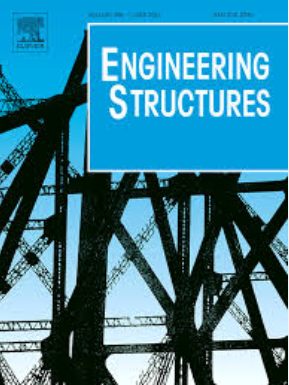Modal strain monitoring of a post-tensioned concrete girder bridge: Influence of temperature and solar irradiation
IF 5.6
1区 工程技术
Q1 ENGINEERING, CIVIL
引用次数: 0
Abstract
Vibration-based monitoring (VBM) is widely applied for assessing the structural health of bridges, where tracking changes of modal characteristics is used for damage assessment. Natural frequencies are the most commonly employed modal characteristic for this purpose, but have the drawback that they are sensitive to temperature changes and not very sensitive to local stiffness variations. Recent case studies, primarily on steel railway bridges, have demonstrated that strain mode shapes offer a much higher sensitivity to local damage and are significantly less influenced by temperature. This study investigates the impact of temperature and solar irradiation on the natural frequencies and strain mode shapes of a post-tensioned concrete bridge used for vehicle traffic. For this purpose, a long-term monitoring campaign is performed, measuring operational dynamic strains and temperature. In agreement with existing case studies in literature, a significant impact of temperature and solar irradiation on the natural frequencies is observed. However, contrary to previous findings, also the strain mode shapes are found to be substantially temperature-dependent. This dependency is attributed to several factors: (1) the composite nature of the structure, where different materials have differing relationships between material properties and temperature, (2) the non-uniform temperature distribution caused by solar irradiation, and (3) the potential impact of changing support conditions and connections with varying temperatures. A finite element model was developed to capture these temperature-dependent effects, successfully replicating the observed temperature-induced changes in both natural frequencies and strain mode shapes. These findings suggest that composite bridges composed of diverse materials exhibit inherent variability in strain mode shapes, primarily due to their temperature dependency. For vibration-based damage detection, this implies that damage has to be sufficiently large to be detected through changes in strain mode shapes or neutral axis positions, if environmental variability is not accounted for.
求助全文
约1分钟内获得全文
求助全文
来源期刊

Engineering Structures
工程技术-工程:土木
CiteScore
10.20
自引率
14.50%
发文量
1385
审稿时长
67 days
期刊介绍:
Engineering Structures provides a forum for a broad blend of scientific and technical papers to reflect the evolving needs of the structural engineering and structural mechanics communities. Particularly welcome are contributions dealing with applications of structural engineering and mechanics principles in all areas of technology. The journal aspires to a broad and integrated coverage of the effects of dynamic loadings and of the modelling techniques whereby the structural response to these loadings may be computed.
The scope of Engineering Structures encompasses, but is not restricted to, the following areas: infrastructure engineering; earthquake engineering; structure-fluid-soil interaction; wind engineering; fire engineering; blast engineering; structural reliability/stability; life assessment/integrity; structural health monitoring; multi-hazard engineering; structural dynamics; optimization; expert systems; experimental modelling; performance-based design; multiscale analysis; value engineering.
Topics of interest include: tall buildings; innovative structures; environmentally responsive structures; bridges; stadiums; commercial and public buildings; transmission towers; television and telecommunication masts; foldable structures; cooling towers; plates and shells; suspension structures; protective structures; smart structures; nuclear reactors; dams; pressure vessels; pipelines; tunnels.
Engineering Structures also publishes review articles, short communications and discussions, book reviews, and a diary on international events related to any aspect of structural engineering.
 求助内容:
求助内容: 应助结果提醒方式:
应助结果提醒方式:


